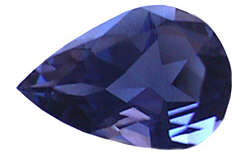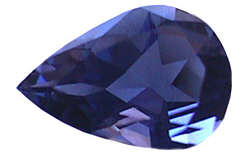You may never have heard of the iolite gem. It isn’t a household word, but it is an attractive indigo colored gemstone. It has been called a “water sapphire”. Iolite is highly trichroic; in one direction it is totally colorless, this aspect was the origin of the water description.
The “blue denim” gemstone is another deserving description. Iolite has a color with its own personality and deserves to be considered on its own merits rather than as a substitute for sapphires or tanzanites. Iolite is often used in jewelry with other colored gemstones such as amethyst, rhodolite, and pink tourmaline.
 |
| Iolite, 4.76 carats (Photo by David Dikinis) |
The color of iolite ranges from a light blue-violet to a very dark blue. A medium dark blue is considered the “best” shade. Small iolites are plentiful and will fall into the low price per carat range. Larger stones (three carats or more) can fall into the moderate range if the color is good. Some stones are included; good clarity is important; avoid sleepy stones.
Iolite Gem Properties
| Colors: | Blue to violetish blue |
| R.I.: | l.54 – l.55 |
| Durability: | Slightly fragile |
| S.G.: | 2.57 – 2.66 |
| Treatment: | None known |
| Hardness: | 7 – 7 1/2 |
| Availability: | Adequate supply |
| Localities: | India, Zimbabwe |
| Price: | Low to moderate |
| Common shapes: | All possible in sizes up to l0 carats |
Iolite should be set in a mounting that provides some protection since it has a cleavage in one direction and is slightly brittle.
Iolite derives its name from Greek, “ios” meaning violet and “lithos”. The mineral cordierite was named after a French geologist, Mr. Cordier, who first studied it.

